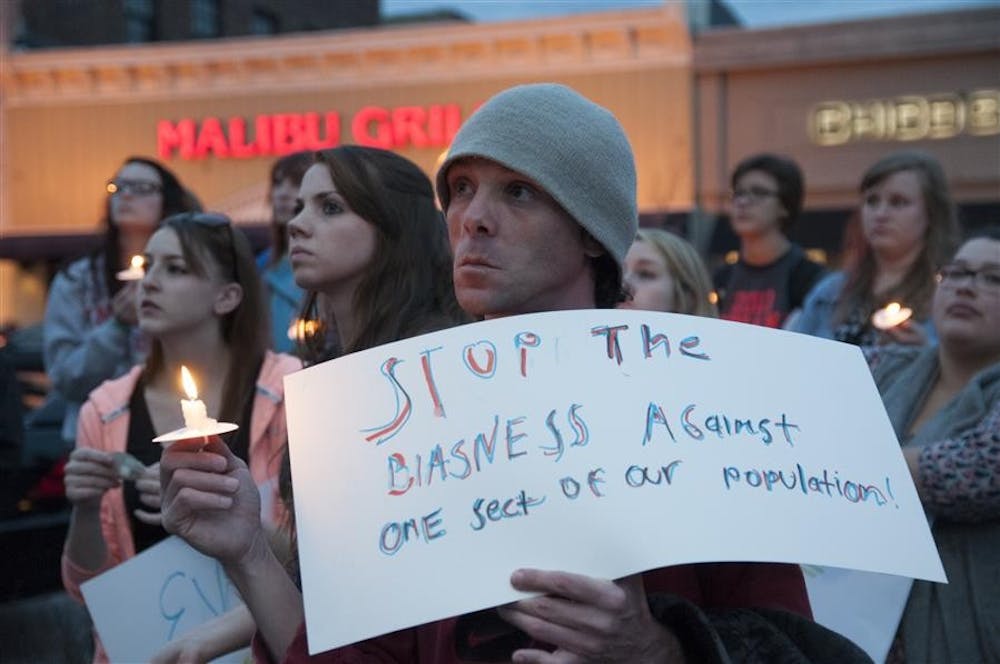Traffic came to a halt as protesters chanted and marched through the downtown streets of Bloomington for the right to sleep.
A hodge-podge of advocates rallied Tuesday at People’s Park after the Interfaith Winter Shelter closed for the summer.
Interfaith is the only low-barrier homeless shelter in Bloomington, which means it has no stipulations for potential guests. Volunteers only ask for respectful behavior.
This will be the second summer that more than 50 people will have nowhere to sleep because they do not meet the high-barrier standards for admittance to other shelters.
Bloomington used to have a low-barrier summer shelter for the homeless, but it shut down in 2012, said Donyel Byrd, a social worker and advocate for people experiencing homelessness. Byrd has been active in helping find a replacement ever since.
There are certain zoning standards the shelter has to meet before the city approves it, Bloomington planning director Tom Micuda said.
If advocates propose a site to the city in a residential area, the Bloomington Plan Commission has to have a public hearing on it and make a recommendation to the City Board of Zoning Appeals. The process could potentially take as long as 60 days and 30 days for any additional hearings.
Byrd and several other advocates found a property on the city’s northwest side but quickly found they were in a catch-22 situation.
“We can’t apply for grants or raise money until we secure a place,” Byrd said, but the hearing process took so long the owner of the property sold it to a buyer who had money.
The only way advocates could secure a shelter site by summer is if the site meets the conditional use permit requirements, which means the site has to be a commercial, medical or institutional space.
Advocates have found no such places yet, Byrd said.
“When you tell people you’re looking for property for a homeless shelter they have a lot of concerns, and many times (are) not willing to rent their property for that use,” Byrd said.
Ross Martinie-Eiler, rally organizer and advocate, led the march west down Kirkwood Avenue all the way to Morton Street.
Marinie-Eiler said there used to be several places for people experiencing homelessness to camp, but the city has systematically rooted out all those places.
“The need is for legal, safe places to sleep,” he said.
Marinie-Eiler led the march followed by a small band equipped with a portable PA system, clogging traffic and turning heads all the way to the Monroe County Courthouse.
The area Marinie-Eiler referred to used to be called the Switchyard Park before the city acquired it from the CSX Railroad Company, said Mick Renneisen, Parks and Recreation Department director.
“There might have been a time where folks camped there before we owned that property,” Renneisen said.
Since the 2009 purchase, the city has built the B-Line Trail through the property and enforces the policy of no camping.
Traffic came to a complete halt on North College Avenue in front of the courthouse as advocates chanted, “Our passion for freedom is stronger than their prison.”
Several city police cars showed up, circling the area as advocates wound around the courthouse for their candlelit vigil and short order of speakers.
Advocate Joe Varga asked for a moment of silence for those who had died of homelessness before introducing speakers.
Traffic surrounding the courthouse returned to its usual rhythm as advocates held their candles in silence.
Standing at the top of the stairs on the corner of Kirkwood Avenue and Walnut Street, Trevor Richardson, a man experiencing homelessness, called out to the crowd.
“You have to speak,” Richardson said. “You have to march. It starts with us. You want change. You seek change.”
Before the march, Richardson spoke about difficulties he encountered while trying to find a job to better himself. He said he felt discriminated against by an employer because an investigative consumer report they conducted on him cited his stays at the Shalom Center as a high-risk indicator.
“This is a dangerous trend,” Richardson said. “We are trying to better ourselves and apply for jobs and we get denied because we have gone to agencies to assist us in bettering ourselves.”
The sun began its decent and the candles glowed. Byrd recalled her last time on the courthouse lawn in 2012 after the Sandy Hook shooting.
“Together we expressed solidarity with those who were grieving,” Byrd said. “Tonight, together we stand united to share our concern about a different kind of tragedy. This is the tragedy of our neighbors who have nowhere safe, warm or legal to sleep at night.”
She said at least 50 people would likely have nowhere to sleep that night.
“Together we can show we care and unite against this tragedy,” Byrd said. “After all, Bloomington is a home for all of us.”
Advocates rally for low-barrier shelter

Get stories like this in your inbox
Subscribe





